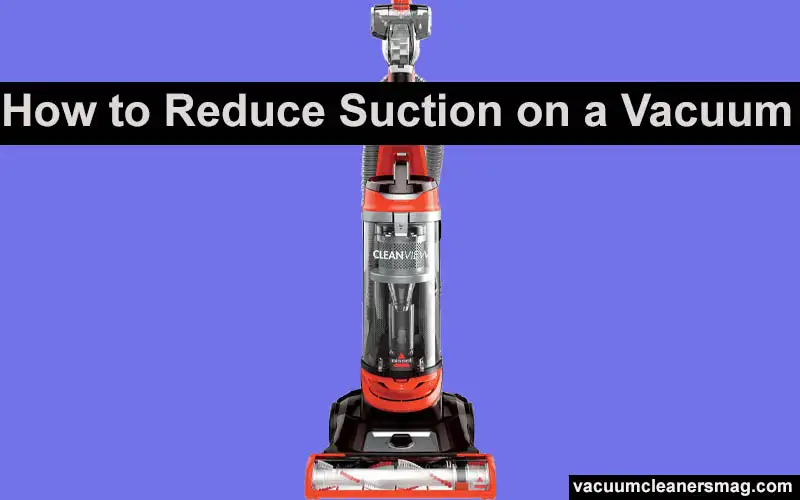The “selling point” of a vacuum cleaner consists of its suction power. Just like humans, vacuum cleaners have evolved as well, in all aspects. However, the mechanism that determines the suction of a vacuum cleaner remains the same.
Today we will discuss suction mechanism of a vacuum cleaner and will also discuss how to adjust its suction if you have to. If your vacuum shows too much suction on carpet or some other wooly surface it becomes difficult to push vacuum cleaner on carpet.
So, we will be covering various ways to reduce suction of a vacuum cleaner.
Suction Power – High and Low
Vacuum cleaners with relatively high suction power are mostly used in households and industrial areas. Why? Well, they are capable of performing efficiently on multiple surfaces making them ideal for these environments.
Another benefit of these vacuum cleaners is that they come with an option that can be used to change the suction power, due to this, they can get themselves accustomed to the type of area they’re about to clean.
Vacuums with lower suction power, however, aren’t that capable. They can be used in small areas, such as offices. Their low suction power doesn’t allow them to clear dust or debris as efficiently as vacuum cleaners with higher suction power.
You can say that these types of vacuum cleaners can be used to remove “visible” dust/debris only.
Suction Power – How to Reduce it in a Vacuum Cleaner?
High-suction vacuum cleaners are preferred over the ones with lower suction power. However, not always do they help you in time of need.
To change the suction power of your vacuum cleaner, there are a set of DIY hacks which you can use to tackle this problem.
Following is a step-by-step guide that you can use to change/reduce the suction power of your vacuum cleaner:
Removal of the Soleplate
Removing the soleplate is one of the easiest and safest methods when it comes to reducing the vacuum cleaner’s suction power. Soleplate is present at the edge of your vacuum cleaner and plays a vital role.
Soleplate keeps the brush bar of a vacuum cleaner in place. For its removal, all you have to do is turn the “slotted keys”.
Quick tip
It is advised to first cleanse your vacuum cleaner’s narrow channel. You can do so by simply cleaning it with a toothbrush or any other elongated object which is capable of doing the job.
Drilling a hole
This method, being the most common one, is also a permanent solution. This means that once you use this method, your vacuum cleaner’s old high suction power isn’t coming back.
To perform this solution, you’ll have to first drill a hole in your vacuum’s tube, then cover it with a cloth or tape, to constrict the airflow. By doing so, you’ll be able to reduce the suction power of your vacuum cleaner according to your needs.
Vacuum Slider
If you have recently bought a vacuum cleaner, then you’re likely to find a slider on it. Vacuum sliders are an option that is present on almost all vacuums, and what it does is that it controls airflow, making your job easier, without you having to drill a hole or anything else.
A vacuum slider is usually located around a vacuum cleaner’s handle.
Attachment of a Crevice tool
“Last but not least!” The crevice tool comes in handy when your cleaner shows too much suction on woolen surfaces, by increasing the distance between your vacuum’s brush and the air production.
You can attach the crevice tool to your vacuum’s handle while its edge to its hose. This will allow you a sufficient reduction in your vacuum’s suction power.
Vacuum Suction Power – Why is it important?
Although vacuums with high suction power are generally considered more efficient, there are still drawbacks to them.
A vacuum cleaner with high suction power causes noise pollution, you might notice that if you have a vacuum cleaner with high suction power, the amount of noise it generates is deafening.
Vacuum cleaners that have high suction power also take more out of you, due to their high suction, they stick to surfaces which in turn causes you to put in more work to remove and move your vacuum cleaner.
The high suction power of a vacuum cleaner results in more power consumption. This can cause your vacuum cleaner to overheat in a short period, causing the motor to shut down.
Vacuums with higher suction power also affect the cleaner’s durability, since it consumes more power.
Moderate Suction Power
A vacuum cleaner that has moderate suction power is your go-to. I say this because when your vacuum will have moderate suction, it won’t perform as efficiently as a vacuum cleaner with higher suction, but it’ll still manage to fulfill your needs.
Its performance won’t drop as low as vacuum cleaners with low suction power, hence, you’ll not be at loss. Other than this, your vacuum cleaner won’t have to face the drawbacks which you’ll encounter with a vacuum cleaner of high suction power.
Conclusion
Vacuum cleaners come in either higher, or lower suction power. This can affect their use in various conditions. Due to the drawbacks faced while possessing a vacuum cleaner with high suction power, consumers look to reduce the suction power on their vacuum cleaners.
This can be done in various ways, some are permanent fixes while some are temporary.
Both types of vacuum cleaners have their advantages and disadvantages, hence, the best suction power to get out of your vacuum cleaner would be moderate.

Hi Everyone.
I’m Safeer. I always loved trying out the latest cleaning and home products and sharing my thoughts about those products with you awesome people. Whether it’s related to general cleaning or it includes cleaning with high-tech vacuum cleaners, I always test them myself and then share valuable opinions with you. Additionally, I also let you know how to resolve particular issues of vacuum cleaners. To look for detailed reviews and troubleshooting tips about vacuum cleaners VaccumCleanersMag is the perfect abode for you.


Try removing the little bit of foam out of the suction control thingy on the metal part of the handle – works wonders! You can also then have twist that same moveable suction control bit left or right to get fine tuning.